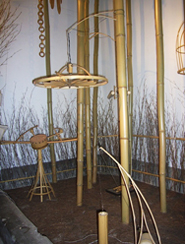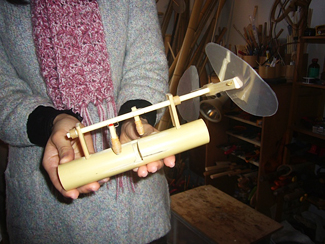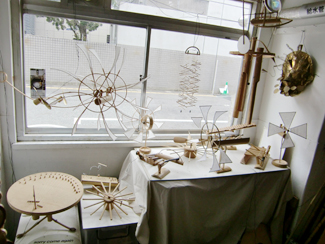 |
|
 |
| Akinori Matsumoto and a wallful of sound objects at Akinorium. |
|
A propeller is positioned to blow air across a slot carved in a large stalk of bamboo, generating a resonant hum. |
Step into Akinori Matsumoto's tiny atelier near the Yokohama docks and you are gently bombarded by a low cacophony of whirring and clicking that is curiously soothing to the soul. The sounds are made by the menagerie of devices in motion, all of Matsumoto's invention, that fill every nook and cranny of the studio. Made mostly of bamboo, wire, and paper, they look like the organic offspring of Rube Goldberg's wacky fantasy machines, but the tasks they perform are strictly in the service of art -- or more precisely, music. Operating on wind or water power, or on tiny, deftly hidden, battery-operated motors, Matsumoto's gadgets are built to make sounds. Wooden clackers clack, paper fans twirl, and little propellers blow air across slots in bamboo tubes, producing the breezy purr of an automated shakuhachi.
Matsumoto, a spry, compact man of 60, explains that he began his career as a "conventional" artist who painted oils and made videos, but discovered that more than anything he wanted to communicate with people through sound. Not feeling inclined to take up a musical instrument, he began constructing what he calls ongu -- sound objects -- that are fun both to look at and listen to. Over many years of experimentation (he has been at this since age 30) he settled on bamboo as his material of choice. "I just happened to pick up a bunch of stalks one day and started playing with them. Bamboo is easy to find, easy to work with, and I like the sounds you can make with it. Nowadays I buy it from a local bamboo shop." Bamboo shop? "Yes, most of their customers are purchasing bamboo to decorate upscale Japanese-style restaurants, so they're not quite sure what to make of me."
 |
|
 |
| The "bamboo grove" in a corner of Akinorium, with various sound-making gadgets among the trees. |
|
Matsumoto applies the finishing touches to a workshop participant's first ongu. |
Matsumoto's sound-object installations have proven popular with people of all ages, garnering considerable attention in recent years. Long queues greeted his exhibitions at the 2009 Niigata Water and Land Art Festival and the 2010 Setouchi International Art Festival. One of the activities he enjoys most is arranging "orchestras" that utilize dozens of his creations for spontaneous musical performances. With a decidedly gamelan-like quality to the sound and look of his instruments, it is no surprise that he has earned a following in places like Bali.
I encountered Matsumoto's work only recently, when I happened to look in on his solo exhibition this past January at
Art Front Gallery in Daikanyama, Tokyo. The venue was more spacious and sedate than his studio, with an air of elegance provided by some lovely light installations interspersed among the humming devices, but the sheer zaniness of the gizmos on display could not be denied. I imagined that the artist's actual workshop must be a place of whimsical and utter chaos. When I finally paid a visit to Akinorium, his Yokohama studio, I was not disappointed.
Occupying a narrow but high-ceilinged room on the ground floor of BankArt Studio NYK, a huge converted warehouse facing Yokohama harbor, Akinorium has
ongu hanging from the rafters, stacked along the walls, and strewn underfoot. Just one corner, where Matsumoto has created a shower-stall-sized bamboo grove, provides a bit of Zen respite from the visual and aural intensity of the space.
 |
|
 |
The completed instrument, with propeller-driven clappers that tap the bamboo tube as they rotate.
|
|
A paper-and-bamboo mobile hanging from the high ceiling of Akinorium, which occupies a corner of a former shipping line warehouse. |
Matsumoto has been an artist-in-residence at Studio NYK for the past year and a half, but he will be vacating the premises at the end of March and moving to new quarters up the street in the even vaster Shinko Pier, another exhibition space managed by the BankArt organization that served as a venue for the Yokohama Triennale last fall.
Since early February Matsumoto has been conducting workshops in the fine art of making
ongu at Akinorium every Saturday. At a recent class, the third in the series, the studio was filled with a half-dozen pupils who were on the verge of completing their first sound objects. Matsumoto moved around the room, adding a touch of glue here, a quiet suggestion there. By the end of the session six very pleased people were showing off their creations and making a pleasant collective din with them.
Matsumoto's "Let's make bamboo sound objects" workshop continues on Saturdays March 3, 10, 17, and 24, from 2:00 to 4:30 p.m. To visitors who just want to drop by, he says, "Tell them to come right in!" To formally participate in the workshop, however, it's best to sign up in advance by emailing BankArt School:
school@bankart1929.com.
 |
|
 |
| This mask is a musical instrument. When you strike the surface -- or any of its appendages -- a pickup mic inside transmits the vibrations to a guitar amplifier, producing gamelan-like sounds that vary depending on where you tap the mask. |
|
A sampling of Matsumoto's creations in the window of his studio at BankArt NYK. Photo courtesy of Akinori Matsumoto.
All photos by Alan Gleason except where noted,
with permission from Akinori Matsumoto |